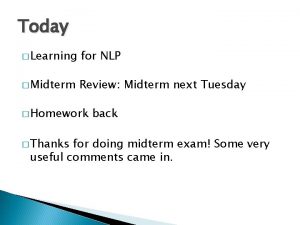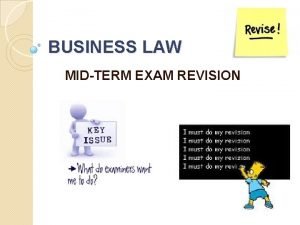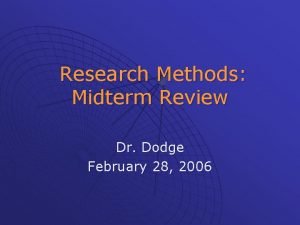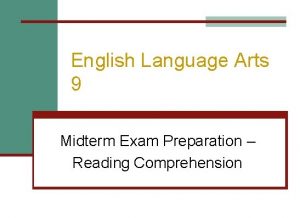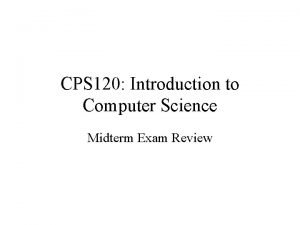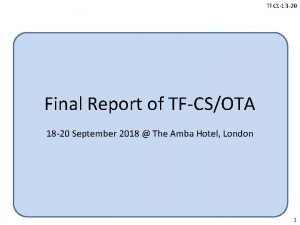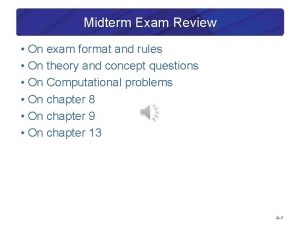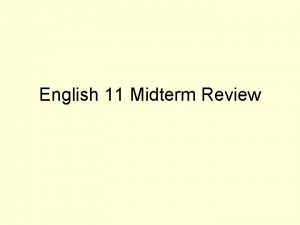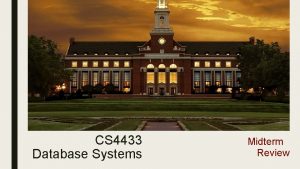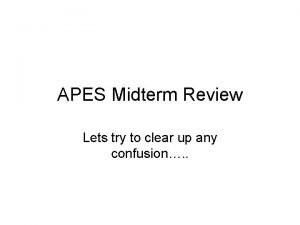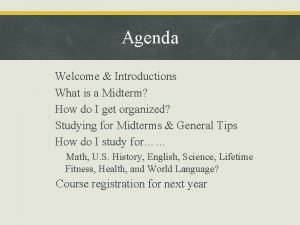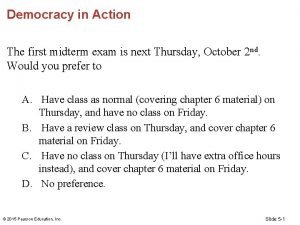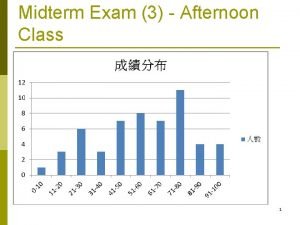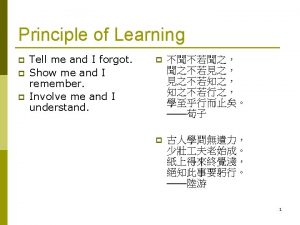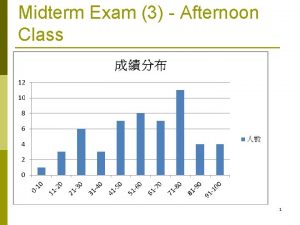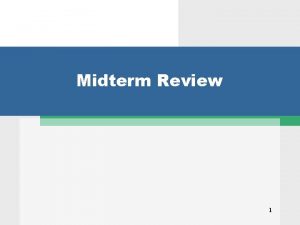Announcements MidTerm Exam Next Thursday In class onepage






















- Slides: 22

Announcements Mid-Term Exam!! Next Thursday!! In class, one-page note Quiz 5 Again + Quiz 6 Answers Exercise 5 Answer Homework 8 Answer Mid-Term Exam: Next Thursday! 2/5/2022 Kelvin Sung (Use/Modify with permission from © 2010 -2012 Larry Snyder, CSE) 1

Datatypes and Functions Kelvin Sung University of Washington, Bothell (* Use/Modification with permission based on Larry Snyder’s CSE 120 ) © Lawrence Snyder 2004

Plan For Today Two ideas – data types and functions – are already familiar to you, because you’ve been using them Today, we teach their details Data types Functions Also, today, we’ll cover some handy “tricks” using those ideas 2/5/2022 Kelvin Sung (Use/Modify with permission from © 2010 -2012 Larry Snyder, CSE) 3

Data Types Information has certain properties … we group information with similar properties into “types” - integers, or whole numbers floating point, usually called decimal numbers colors, a triple of numbers for R, G and B Etc. In order for computers to process data, they need to know its type So, we always specify the data’s type 2/5/2022 Kelvin Sung (Use/Modify with permission from © 2010 -2012 Larry Snyder, CSE) 4

Give Datatypes in Declarations �Processing has a series of datatypes �The most important datatypes for us are int, float, boolean and color Find details in the references �When declaring variables we list them after the type, as in int x, y, z; float half_step = 0. 5, whole = 1. 0; color yellow = color(200, 0); 2/5/2022 Kelvin Sung (Use/Modify with permission from © 2010 -2012 Larry Snyder, CSE) 5

Examples: At Top of a Program 2/5/2022 Kelvin Sung (Use/Modify with permission from © 2010 -2012 Larry Snyder, CSE) 6

At The Top of Functions 2/5/2022 Kelvin Sung (Use/Modify with permission from © 2010 -2012 Larry Snyder, CSE) 7

Global Variable Preserve Info 2/5/2022 Kelvin Sung (Use/Modify with permission from © 2010 -2012 Larry Snyder, CSE) 8

Hiding In Another Function … 2/5/2022 Kelvin Sung (Use/Modify with permission from © 2010 -2012 Larry Snyder, CSE) 9

Functions, A Review Functions have been used in Lightbot 2. 0: F 1 Functions in HW 03: F. turn( ), HW 05: Cols … We’ve used functions, also known as procedures, methods, subroutines in all of our Processing code: size(200, 200) Recall that functions have two parts: function definition … declaration of its instructions function call … a request to run the function Let’s get the details down now … 2/5/2022 Kelvin Sung (Use/Modify with permission from © 2010 -2012 Larry Snyder, CSE) 10

Functions In Processing The form of function definition in Processing <return type> <name> ( <param list> ) { <body> } as in or 2/5/2022 void draw_a_box (int x_pos, int y_pos) { rect(x_pos, y_pos, 20); } color pink ( ) { return color(255, 200); } Kelvin Sung (Use/Modify with permission from © 2010 -2012 Larry Snyder, CSE) 11

Functions In Processing The form of function definition in Processing <return type> <name> ( <param list> ) { <body> } as in or 2/5/2022 void draw_a_box (int x_pos, int y_pos) { rect(x_pos, y_pos, 20); } color pink ( ) { return color(255, 200); } Kelvin Sung (Use/Modify with permission from © 2010 -2012 Larry Snyder, CSE) 12

Functions In Processing: Result Functions that do something, but do not return a value, have void as their <return type> Functions that return a value must say the datatype of the value returned void draw_a_box (int x_pos, int y_pos) { rect(x_pos, y_pos, 20); } color pink ( ) { return color(255, 200); } 2/5/2022 Kelvin Sung (Use/Modify with permission from © 2010 -2012 Larry Snyder, CSE) 13

Functions In Processing: Params Parameters are the values used as input to the function; parameters are not required, but the parentheses are The type of each parameter must be given void draw_a_box (int x_pos, int y_pos) { rect(x_pos, y_pos, 20); } color pink ( ) { return color(255, 200); } 2/5/2022 Kelvin Sung (Use/Modify with permission from © 2010 -2012 Larry Snyder, CSE) 14

Functions In Processing: Args An argument is the input value given to a parameter when a function is called, as in draw_a_box(50, 200); The value of the argument becomes the value of the corresponding parameter: draw_a_box(50, 200); void draw_a_box (int x_pos, int y_pos) { rect(x_pos, y_pos, 20); } 2/5/2022 Kelvin Sung (Use/Modify with permission from © 2010 -2012 Larry Snyder, CSE) 15

Functions In Processing: Return A function returns its value with the return statement … the stuff following return is the result The function is done when it reaches return void draw_a_box (int x_pos, int y_pos) { rect(x_pos, y_pos, 20); } color pink ( ) { return color(255, 200); } 2/5/2022 Kelvin Sung (Use/Modify with permission from © 2010 -2012 Larry Snyder, CSE) 16

Plan The Function in Declaration The function has a name, parameters, def Name: draw. Column Parameters: int offset; Definition: rect(20+offset, 250, 60, 20); rect(30+offset, 270, 40, 10); ellipse(30+offset, 275, 10); ellipse(70+offset, 275, 10); rect(35+offset, 280, 30, 60); Nothing has to be returned 2/5/2022 Kelvin Sung (Use/Modify with permission from © 2010 -2012 Larry Snyder, CSE) 17

The Function Declaration & Calls The result: The calls 2/5/2022 Kelvin Sung (Use/Modify with permission from © 2010 -2012 Larry Snyder, CSE) 18

Parameters are automatically declared (and initialized) on a call, and remain in existence as long as the function remains unfinished When the function ends, the parameters vanish, only to be recreated on the next call It is wise to choose parameter names, e. g. o -f-f-s-e-t that are meaningful to you I chose offset as the orientation point of the figure in the x direction Notice that I used that name a lot, and the meaning to me remained the same 2/5/2022 Kelvin Sung (Use/Modify with permission from © 2010 -2012 Larry Snyder, CSE) 19

Arguments Become Parameters Notice that if the DEFINITION has n parameters, the CALL needs n arguments The parameters and arguments correspond Inside of the function, the parameter, e. g. xbase, is declared and initialized to the corresponding argument, e. g. 80. Then, the definition uses it, e. g. rect(80, 40+10, 20, 40) 2/5/2022 Kelvin Sung (Use/Modify with permission from © 2010 -2012 Larry Snyder, CSE) 20

Using Functions + Global Variables Mouse clicks control the direction … dir flips from 1 to -1 on each click 2/5/2022 Kelvin Sung (Use/Modify with permission from © 2010 -2012 Larry Snyder, CSE) 21

Summary on Functions When we have something we have to produce and perhaps use repeatedly, we need a function We need two things: a declaration, and calls The declaration is the function “package” The call is the use, where we ask to “run” it So we declared the function, and called it Need to follow the rules on form: “void”, parens, give type of parameters, curly braces, indent, comment, … Use parameter values where changes are needed 2/5/2022 Kelvin Sung (Use/Modify with permission from © 2010 -2012 Larry Snyder, CSE) 22
 Quickparts review
Quickparts review X.next = x.next.next
X.next = x.next.next Nlp midterm exam
Nlp midterm exam Data mining exam
Data mining exam Html midterm exam
Html midterm exam English midterm test
English midterm test Business law midterm exam
Business law midterm exam Research methods midterm
Research methods midterm English 9 midterm exam
English 9 midterm exam Introduction to computer science midterm exam
Introduction to computer science midterm exam Introduction to computer science midterm exam test
Introduction to computer science midterm exam test Ap english language and composition midterm exam
Ap english language and composition midterm exam Algebra 2 midterm review answers
Algebra 2 midterm review answers Grva midterm exam
Grva midterm exam Midterm exam format
Midterm exam format American literature midterm exam
American literature midterm exam Us history semester exam review answers
Us history semester exam review answers English 11 midterm exam
English 11 midterm exam Database systems midterm exam
Database systems midterm exam Oligotrophic definition apes
Oligotrophic definition apes What is a midterm
What is a midterm Geometry midterm exam
Geometry midterm exam Exam midterm
Exam midterm


